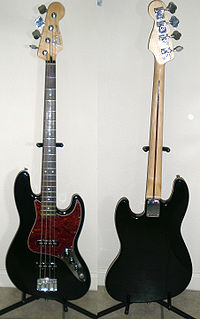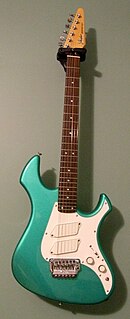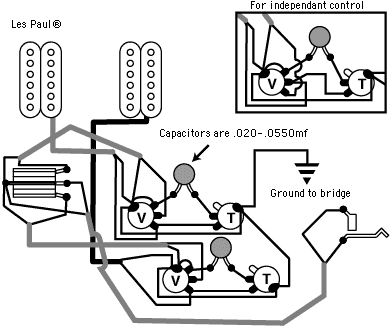The bass guitar, electric bass or simply bass, is the lowest-pitched member of the guitar family. It is a plucked string instrument similar in appearance and construction to an electric or an acoustic guitar, but with a longer neck and scale length, and typically four to six strings or courses. Since the mid-1950s, the bass guitar has largely replaced the double bass in popular music.

A humbucking pickup, humbucker, or double coil, is a type of electric guitar pickup that uses two coils to "buck the hum" picked up by coil pickups caused by electromagnetic interference, particularly mains hum. Most pickups use magnets to produce a magnetic field around the strings, and induce an electrical current in the surrounding coils as the strings vibrate. Humbuckers work by pairing a coil that has the north poles of its magnets oriented "up" with another coil right next to it with the south pole of its magnets oriented up. By connecting the coils together out of phase, the interference is significantly reduced via phase cancellation: the string signals from both coils add up instead of canceling, because the magnets are placed in opposite polarity. The coils can be connected in series or in parallel in order to achieve this hum-cancellation effect, although it is much more common for the coils of a humbucker pickup to be connected in series. In addition to electric guitar pickups, humbucking coils are sometimes used in dynamic microphones to cancel electromagnetic hum.

A single coil pickup is a type of magnetic transducer, or pickup, for the electric guitar and the electric bass. It electromagnetically converts the vibration of the strings to an electric signal. Single coil pickups are one of the two most popular designs, along with dual-coil or "humbucking" pickups.
The Fender Jazzmaster is an electric guitar designed as a more expensive sibling of the Fender Stratocaster. First introduced at the 1958 NAMM Show, it was initially marketed to jazz guitarists, but found favor among surf rock guitarists in the early 1960s. Its appearance is similar to the Jaguar, though it is tonally and physically different in many technical ways, including pickup design, scale length and controls.
The Fender Jaguar is an electric guitar by Fender Musical Instruments characterized by an offset-waist body, a relatively unusual switching system with two separate circuits for lead and rhythm, and a medium-scale 24" neck. Owing some roots to the Jazzmaster, it was introduced in 1962 as Fender's feature-laden top-of-the-line model, designed to lure players from Gibson. During its initial 13-year production run, the Jaguar did not sell as well as the less expensive Stratocaster and Telecaster, and achieved its most noticeable popularity in the surf music scene. After the Jaguar was taken out of production in 1975, vintage Jaguars became popular first with American punk rock players, and then more so during the alternative rock, shoegazing and indie rock movements of the 1980s and 1990s. Fender began making a version in Japan in the mid-1980s, and then introduced a USA-made reissue in 1999. Since then, Fender has made a variety of Jaguars in America, Mexico, Indonesia and China under both the Fender and Squier labels. Original vintage Jaguars sell for many times their original price.

The Fender Jazz Bass is the second model of electric bass created by Leo Fender. It is distinct from the Precision Bass in that its tone is brighter and richer in the midrange and treble with less emphasis on the fundamental frequency. The body shape is also different from the Precision Bass, in that the Precision Bass has a symmetrical lower bout on the body, designed after the Telecaster and Stratocaster lines of guitars, while the Jazz Bass has an offset lower bout, mimicking the design aesthetic of the Jaguar and Jazzmaster guitars.

A pickup is a transducer that captures or senses mechanical vibrations produced by musical instruments, particularly stringed instruments such as the electric guitar, and converts these to an electrical signal that is amplified using an instrument amplifier to produce musical sounds through a loudspeaker in a speaker enclosure. The signal from a pickup can also be recorded directly.

The Fender Telecaster Deluxe is a solid-body electric guitar originally produced from 1972 to 1981, and re-issued by Fender multiple times starting in 2004.
Mains hum, electric hum, or power line hum is a sound associated with alternating current which is twice the frequency of the mains electricity. The fundamental frequency of this sound is usually double that of fundamental 50/60 Hz, i.e. 100/120 Hz, depending on the local power-line frequency. The sound often has heavy harmonic content above 50/60 Hz. Because of the presence of mains current in mains-powered audio equipment as well as ubiquitous AC electromagnetic fields from nearby appliances and wiring, 50/60 Hz electrical noise can get into audio systems, and is heard as mains hum from their speakers. Mains hum may also be heard coming from powerful electric power grid equipment such as utility transformers, caused by mechanical vibrations induced by magnetostriction in magnetic core. Onboard aircraft the frequency heard is often higher pitched, due to the use of 400 Hz AC power in these settings because 400 Hz transformers are much smaller and lighter.
The Fender Lead Series was produced by the Fender/Rogers/Rhodes Division of CBS Musical Instruments. The series comprised Lead I, Lead II, Lead III and Lead Bass models.

The Fender Jaguar Bass is an electric bass guitar manufactured in Japan and China by the Fender Musical Instruments Corporation.

Fender Telecaster Custom is a model of electric guitar made by Fender.
The Fender Stringmaster is a series of console steel guitars produced by Fender from 1953 to 1980.

The Fender Performer was an electric guitar designed by John Page for rock and metal guitarists in the mid-1980s. The Performer was also available as an electric bass.

The Gibson L6-S is a solid body electric guitar. It was the working musician's descendant of the L5S jazz solid-body electric guitar. It was the same shape, very much like a wide Gibson Les Paul, but with a 24-fret two-octave neck, the first Gibson guitar to have this.
The Fender Noiseless series is a line of electric guitar pickups made by the Fender Musical Instruments Corporation. Introduced in 1998, they feature and are a row of dual stacked-coil design to cancel hum noise. This single-coil (size) stack consists of a row of paired single-coils stacked one on top of the other (compacted), so as to fit (incognito) into the same size width space as a regular single-coil pickup. This is to be contrasted with the original humbucking pickup design, which is a row of paired single-coils double wide.
The James Burton Telecaster is a Signature/Artist Series electric guitar made by Fender Musical Instruments Corporation. The guitar is available in two models, Upgrade and Standard, and both were designed by American country-rock guitarist James Burton along with Dan Smith at Fender. Both models are patterned after mid-century Fender Telecaster guitars played by Burton during his long career with Ricky Nelson, Elvis Presley,(James was hesitant to play the now infamous Fender Telecaster pink paisley guitar because it was thought was too bright, Elvis's guys persuaded him to play it live on stage with Elvis and Elvis loved it and wanted him to play it all the time on stage.)Merle Haggard, Emmylou Harris, John Denver and many other well-known artists.
Jens Ritter Instruments is a manufacturer of high-end electric stringed instruments. It was founded by Jens Ritter in the mid-1990s and was known as Ritter Bass Guitars until 2010 when Jens expanded his line to include guitars. Jens produces 50 to 60 handmade instruments each year in his shop located in the small wine town of Deidesheim, Germany. A number of well-known bassists play Ritter Basses including Phil Lesh, Josh Dunham and Doug Wimbish. Jens Ritter Instruments are best known for their progressive design and construction, artistic appearance and limited availability. They also produce strings and other accessories.
The Yamaha Corporation is a multinational corporation and conglomerate based in Japan with a wide range of products and services, predominantly musical instruments, motorcycles, power sports equipment and electronics.
The Fender Telecaster, colloquially known as the Tele, is the world's first commercially successful solid-body electric guitar. Its simple yet effective design and revolutionary sound broke ground and set trends in electric guitar manufacturing and popular music. Introduced for national distribution as the Broadcaster in the autumn of 1950 as a two-pickup version of its sister model, the single-pickup Esquire, the pair were the first guitars of their kind manufactured on a substantial scale. A trademark conflict with a rival manufacturer's led to the guitar being renamed in 1951. Initially, the Broadcaster name was simply cut off of the labels placed on the guitars and later in 1951, the final name of Telecaster was applied to the guitar. The Telecaster quickly became a popular model, and has remained in continuous production since its first incarnation.












